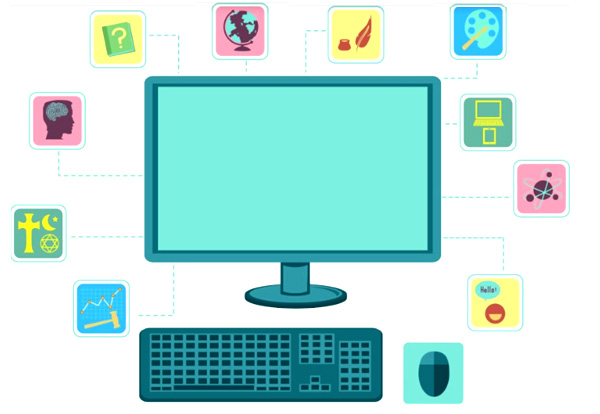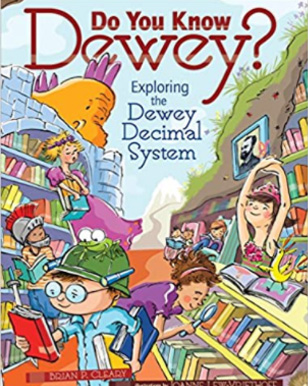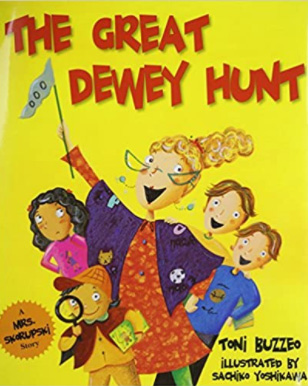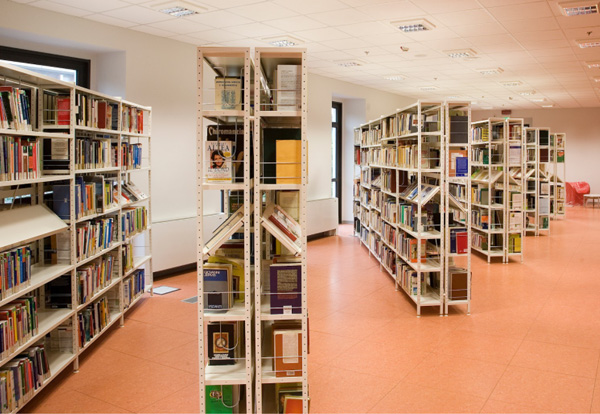"DEWEY" KNOW HOW TO FIND INFORMATION
Finding Nonfiction Resources in a Traditional Library Format
Introduction | Background Knowledge | Activities | Extensions

Introduction
Have you ever been to a bargain store where the items were scattered around? Did you enjoy shopping there? Could you find what you needed? Now consider how you would feel if you were looking for information and couldn't find it.
Luckily, traditional libraries have a solution to that hypothetical problem. Most school libraries use the Dewey Decimal System to categorize and organize nonfiction materials, which allows users to search the catalog and use a logical series of numbers to find what they are looking for. Students need to know how to find nonfiction resources on the shelves before they can be asked to do research.
Background Knowledge

Melvil Dewey created what would become known as the Dewey Decimal Classification in 1873 and published it in 1885-the same year that he founded the American Library Association. The system is centered around 10 major classes with each identified by the first digit of a three digit number. Those categories are then broken down into more specific subjects, identified by the second digit of the three digit number. As the number becomes more specific, the information becomes more specific. For example, a book in the 500s will be about Science. A book in the 590s will be about animals. A book in the 599s will be about mammals. To narrow it down further, a book with a call number of 599.8 will be about non-human primates. The system is very specific and the books can be categorized with very long call numbers. Once categorized, the books are shelved numerically, in decimal order.
Start with Literature
 Do You Know Dewey? By Brian P. Cleary (ISBN 9780761366768) - Written in rhyme, this book makes the Dewey Decimal System accessible
to students by helping them see the categories through their own experiences.
Do You Know Dewey? By Brian P. Cleary (ISBN 9780761366768) - Written in rhyme, this book makes the Dewey Decimal System accessible
to students by helping them see the categories through their own experiences.
 The Great Dewey Hunt by Toni Buzzeo (ISBN 9781602130296) Toni Buzzeo has written another wonderful Mrs. Skorpuski book! In this
installment, Mrs. Skorpuski invites the fourth grade students to explore the Dewey Decimal System and create a scavenger hunt for the second grade.
The Great Dewey Hunt by Toni Buzzeo (ISBN 9781602130296) Toni Buzzeo has written another wonderful Mrs. Skorpuski book! In this
installment, Mrs. Skorpuski invites the fourth grade students to explore the Dewey Decimal System and create a scavenger hunt for the second grade.
Videos
- The Dewey Decimal Classification System (TeachersFirst review) - This video is a great introduction to the Dewey Decimal System and breaks down the categories into easy terms using football, which is a subject that appeals to many students.
- Introduction to the Dewey Decimal System - Made through PowToon, this video is a little less robotic and includes background information about Melvil Dewey. This is a kid-friendly video that does a good job explaining the Dewey Decimal System.
- The Dewey Decimal Rap (TeachersFirst review) - This is a fun way to look at the Dewey Decimal System. This video presents the information in a light-hearted rap.
- Bob the Alien (TeachersFirst review) - Capstone, a book publisher, has created a video about the Dewey Decimal system that helps Bob the Alien find a book about spiders.
Other Online Resources for Background Information
- A Short Story About Dewey (TeachersFirst review) of Slideshare, not this specific product) - This is an engaging look at the Dewey Decimal System. Dewey is said to have invented the classification system by imagining himself as a caveman. This is a cute depiction that invites students to imagine themselves as cavemen and opens the door for excellent conversation!
- Library Skills Free Powerpoints for Kids and Teachers (TeachersFirst review) - This website links to many online games to learn more about the Dewey Decimal system and play games to practice using it.
Activities

Scavenger Hunt
- A scavenger hunt is a great way to keep kids engaged when the topic is not exciting on its own! This can be high tech or no tech! Students follow clues to locate books on the shelves.
Non-Technology Approach
- Easter Egg Hunt - Recycle old Easter Eggs and hide them throughout your space! Students search the room for eggs and in each egg is a clue. The students then use the catalog or their knowledge of the shelves to find the books.
- Team Scavenger Hunt - Each team starts with a clue. The clue will lead them to a book on the shelf. This book will have a new clue. Students will work together to figure out the next clue and locate the book on the shelf. You can color code the clues so that all of the teams are not trying to find the exact same book at the same time.
- AASL National School Library Standards: Curate Shared Foundation, Think Domain (Learners act on an information need by: 1. Determining the need to gather information. 2. Identifying possible sources of information. 3. Making critical choices about information sources to use.)
- AASL National School LIbrary Standards: Include Shared Foundation, Create Domain (Learners adjust their awareness of the global learning community by: 1. Interacting with learners who reflect a range of perspectives.)
Technology Approach
- Create a Goose Chase (TeachersFirst review). Students can complete a GooseChase or create their own!
- ISTE Standards for Students: Knowledge Constructor (3a. Students plan and employ effective research strategies to locate information and other resources for their intellectual or create pursuits. )
- ISTE Standards for Students: Innovative Designer (4d. Students exhibit a tolerance for ambiguity, perseverance and the capacity to work with open-ended problems)
Online Games
- Quizizz (TeachersFirst review) is a great platform to test your students' knowledge of the Dewey Decimal System. There are a number of premade quizzes on Quizizz. There is no practical application, but it is great for learning
about the classification categories.
- ISTE Standards for Students: Empowered Learner (1c. Students use technology to seek feedback that informs and improves their practice and to demonstrate their learning in a variety of ways.)
Extensions

Once students have an understanding about how the Dewey Decimal System works and how to use it to find resources, they can extend their thinking!
- Word Clouds
- Provide groups of students with a sample of books from one of the 10 major classifications of the Dewey Decimal System. Ask them to look at and through the books to see if they can determine keywords that could
describe this particular category. They put their ideas together in a word cloud. (More information about this activity can be found at Making Dewey Fun! A Roundup of Ideas, Games, and Activities -
(TeachersFirst
Review)
. Create shareable products using WordItOut (TeachersFirst review) Word Cloud Generator (TeachersFirst review), or WordClouds (TeachersFirst review)
- ISTE Standards for Students: Creative Communicator (6d. Students publish or present content that customizes the message and medium for their intended audience.)
- ISTE Standards for Students: Global Collaborator (7c. Students contribute constructively to project teams, assuming various roles and responsibilities to work effectively toward a common goal.)
- AASL National School Library Standards: Collaborate Shared Foundation, Grow Domain (Learners actively participate with others in learning situations by: 1. Actively contributing to group discussions. 2. Recognizing learning as a social responsibility.)
- Provide groups of students with a sample of books from one of the 10 major classifications of the Dewey Decimal System. Ask them to look at and through the books to see if they can determine keywords that could
describe this particular category. They put their ideas together in a word cloud. (More information about this activity can be found at Making Dewey Fun! A Roundup of Ideas, Games, and Activities -
(TeachersFirst
Review)
. Create shareable products using WordItOut (TeachersFirst review) Word Cloud Generator (TeachersFirst review), or WordClouds (TeachersFirst review)
- Posters
- Students can create posters/infographics to decorate the library or the classroom, depicting each of the 10 major categories of the Dewey Decimal System. This can be done with poster board and art supplies or with
technology tools such as Google Slides (TeachersFirst review), Microsoft PowerPoint (TeachersFirst review), or BigHugeLabs (TeachersFirst review).
- AASL National School Library Standards: Inquire Shared Foundation, Create Domain (Learners engage with new knowledge by following a process that includes: 3. Generating products that illustrate learning.)
- Students can create posters/infographics to decorate the library or the classroom, depicting each of the 10 major categories of the Dewey Decimal System. This can be done with poster board and art supplies or with
technology tools such as Google Slides (TeachersFirst review), Microsoft PowerPoint (TeachersFirst review), or BigHugeLabs (TeachersFirst review).
- AASL National School Library Standards: Explore Shared Foundation, Share Domain (Learners engage with the learning community by: 1. Expressing curiosity about a topic of personal interest or curricular relevance.
- ISTE Standards for Students: Computational Thinkers (5. ISTE for Students: Computational Thinker 5c. Students break problems into component parts, extract key information, and develop descriptive models to understand complex systems or facilitate problem solving.)
